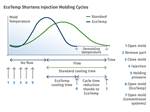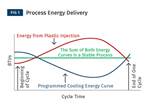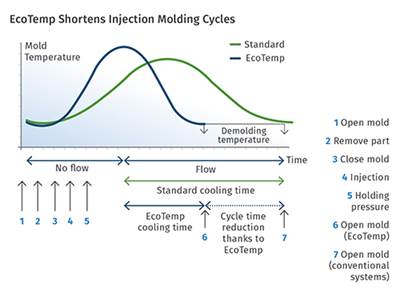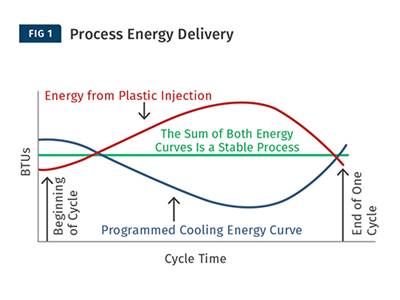Ten Intriguing Injection Molding Technologies of 2015
I know I’m leaving myself wide open on this one. I was asked, “What are the 10 most interesting injection molding technologies of 2015?” I should have pleaded eggnog hangover and politely declined.
I know I’m leaving myself wide open on this one. I was asked, “What are the 10 most interesting injection molding technologies of 2015?” I should have pleaded eggnog hangover and politely declined.
Trying to answer that one is a trap on several levels: First, how do you pin a technology, which takes time to develop and commercialize, to a particular year? And then, what’s “most interesting”? I assume that will depend on your interests: Are you a custom molder, or captive? What markets do you serve—automotive, medical, packaging, you-name-it? Do you operate large machines or small?
With those caveats, here are some things that interested me in 2015. I couldn’t really limit it to 10, so some are areas of technology rather than a particular new development. And I call them technologies of 2015 because they were introduced commercially this past year, featured in major trade shows this year (or at least U.S. trade shows), or they simply came to my attention in that time frame. If you don’t like my selections, send me yours at mnaitove@ptonline.com.
Here are my picks, in no particular order:
Robots: Lots of interesting things appeared in the robot category this past year. NPE2015 in Orlando saw some hints from Star Automation of how onboard vision could make robots smarter and more versatile. Robots equipped to weigh parts are another interesting idea, floated by AGS at NPE and by Wittmann Battenfeld at Fakuma 2015 in Germany. NPE also showed off a “new concept” robot system from Yushin that had two arms and a third sliding, rotating gripper, for a total of 16 servo axes. And in the fast-evolving area of injection molded composites, Sumitomo (SHI) Demag demonstrated an “ovenless” approach to preheating thermoplastic prepregs using heated robot grippers at the fall Fakuma 2015 show in Germany. Also at Fakuma, more robot makers, like Hekuma, joined the movement toward “collaborative robots” that can work safely alongside people. And an entirely new category (for plastics) of robots—so-called Delta, “parallel,” or “spider” robots—made an appearance for high-speed pick-and-place applications. At NPE, Sailor Automation showed a robot that “learns” how to control vibration over a few cycles; and Engel introduced at Fakuma enhanced robot vibration control that responds to external forces in the molding process. For details, see our March NPE preview and June post-show report, as well as our December Fakuma news highlights.

Liquid Silicone Rubber: LSR continues to attract new technology. NPE saw a jaw-dropping demonstration of nine-color, eight-durometer molding by LSR specialist Silcotech on a single-barrel Arburg machine. Also shown at NPE were an auxiliary injector for LSR from MGS Mfg., a micro LSR injector from Kipe Molds, and a spiral-grooved plunger for LSR injection from Nissei America. See the June NPE report and May Close Up on the show.

In-Mold Labeling: Again, NPE highlighted several interesting developments: a technique from Beck Automation that rearranges the cores on a deep-draw stadium-cup mold to greatly reduce the opening stroke; a technique demonstrated by Sumitomo Demag that produces a full-wrap label plus features that are injected through the label to project beyond the outer wall of the cup; partially precut labels from CBW Automation that avoid the limitations of fully precut labels or die cutting at the molding station. Fakuma 2015 demonstrated an unusually flexible and versatile IML system from Beck Automation that can quickly change the number of cavities, container size, label type, and gating method (see October Starting Up).

Coinjection: At NPE, Husky showcased its entry into the promising field of barrier coinjected food and beverage containers (see March Close Up). And Milacron marshalled technologies from its Mold-Masters, Kortec (now Milacron Co-Injection Systems), and other brands to push its Klear Can retortable PP/EVOH container closer to commercialization (see December Starting Up).
Mold Temperature Control: Closing one of the remaining gaps in injection process control, Engel showed its electronic water-flow monitoring and closed-loop control system at NPE, and Wittmann exhibited its version at the last two Fakuma shows (see Dec. ’14 Close Up). At NPE, Single showed off its “poor man’s variotherm” a less expensive, “passive” form of heat/cool molding (see February Close Up). An entirely new maker of mold temperature controllers offers a different approach to “passive” variotherm and standard cooling control (May Close Up). Also at NPE, Roctool used variotherm molding with its induction heating technology to push the boundaries of in-mold decorating capabilities without labels or secondary processes.
Melt-Temperature Control: Shining light on the long-standing “mystery” of melt temperature inside the barrel, Md Plastics offered a new type of nozzle sensor that provides a wide range of data about the state of the melt during processing; and Futaba introduced infrared melt-temperature sensors that are immune to influence by surrounding steel of the nozzle or mold. For details, see October Close Up and Keeping Up.
3D Printed Mold Cavities: At several recent shows, including NPE and Fakuma, companies such as Milacron, Toshiba, Boy Machines, and Hasco showed how 3D printed plastic cavity inserts offer potential for quick-turn molds that can produce up to 500 parts. See July NPE report and December Starting Up.
Biopolymer Molding: I was intrigued to find a processor that has built a business entirely on molding plant-based biopolymers for disposable packaging. See August Close Up.
Clamp Force Optimization: Just introduced by Engel at Fakuma 2015 is a system for automatic optimization of clamp force to maximize part quality while extending mold life and minimizing energy consumption.
Self-Cleaning Mold: High-volume PET preform molders can save hundreds of hours of mold-maintenance downtime, using a technique from Husky that’s dazzling in its simplicity. See May NPE Close Up.
Read Next
‘Passive Variotherm’ Cooling Cuts Cycle Time at Low Cost
A hot/cold molding technique lets the injected melt do the heating while water flow is paused.
Read MoreA Challenger Tackles Coinjection For Barrier PET Preforms
Barrier PET containers for beverages, sauces, and other sensitive products become more cost-effective through more efficient use of expensive barrier resins.
Read MoreA New Name & New Dimension in Mold- Temperature Control
Controlling both water temperature and flow rate promises dramatic savings in energy and cycle time.
Read More






















